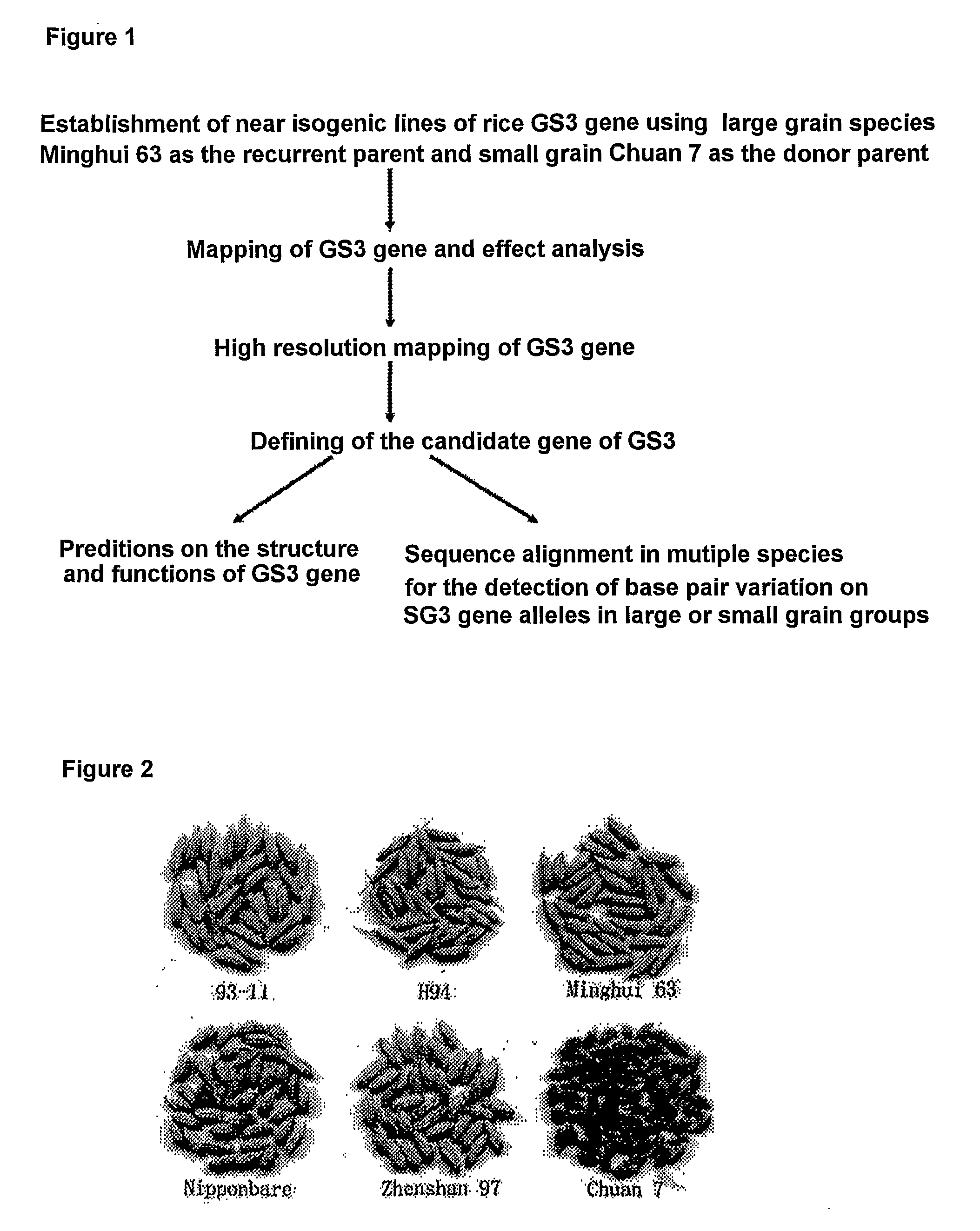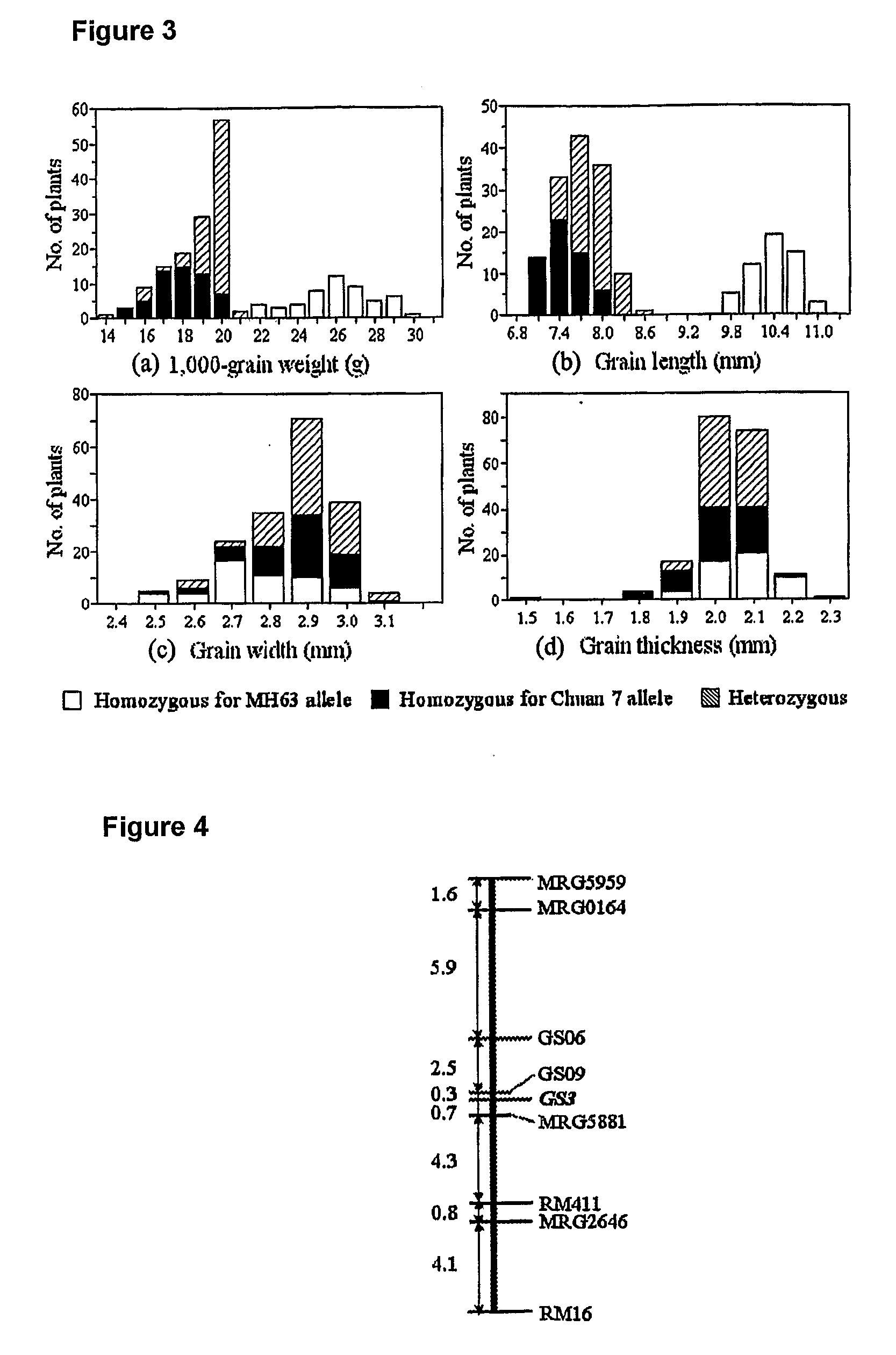Rice Gene, GS3, Exerting Primary Control Over Grain Length and Grain Weight
a technology of gs3 and rice, which is applied in the field of plant biotechnology, can solve the problems of complex genetic basis, large size of rice, and difficult high-resolution mapping of quantitative traits in common population groups
- Summary
- Abstract
- Description
- Claims
- Application Information
AI Technical Summary
Benefits of technology
Problems solved by technology
Method used
Image
Examples
example 1
Establishment of a Near Isogenic Lines of Rice GS3 Gene
1. Backcrossing and Screening
[0025]As shown in FIG. 2, successive crossing was carried out using Minghui 63 (large grain) as the recurrent parent and Chuan 7 (small grain) as the donor parent. Positive selection of GS3 was carried out in F1, BC1F1 and BC2F1, that is, selecting individual plants whose targeting region was Minghui63 / Chuan7 heterozygous genotype for the following backcrossing. The targeting region was determined in a region between two known SSR (Simple Sequence Repeat) markers RM282 and RM16. In BC3F1, in addition to positive selection, surveillance was also carried out in the genetic backgrounds besides the targeting region. Individual plants with a genetic background closest to Minghui63 were selected for the following experiments. Referring to the published rice genetic linkage map (Temnykh et al., 2000, Theor. Appl. Genet. 100:697-712; Temnykh et al., 2001, Genome Res. 11:1441-1452), 125 SSR markers with known...
example 2
Mapping and Effect Evaluation of GS3 in the Random Subpopulation
1. Measurements of Traits of Large and Small Grain
[0027]Grain particles were air-dried and stored at room temperature for at least 3 months before testing in order to make sure the dryness and water contents thereof were relatively identical. Ten randomly chosen full filled grains from each plant were lined up closely in a way that each lay head to head, tail to tail, with no overlap and no gap in between. Said grains were arranged length-wise to measure the grain length using a vernier caliper, and then were lined up closely side by side, that is, arranged by breadth to measure the grain width using a vernier caliper. Grain thickness was determined for each grain individually using a vernier caliper, and the values were averaged and used as the measurements for the plant. Grain weight was calculated based on 200 randomly chosen fully filled grains and converted to 1,000-grain weight.
[0028]201 individuals of BC3F2 deriv...
example 3
High Resolution Mapping of GS3
1. CAPS Analysis
[0032]9 CAPS markers used for the high resolution locating are listed in Table 2. The amplification product amplified by said markers had a size of around 1-kb. The PCR reaction system was identical with the SSR reaction system mentioned above. The amplification condition of the PCR was as below: 94° C. predenature 4 min; 94° C. 1 min, 53° C.˜57° C. 1 min, 72° C. 1.5 min, 34 cycles; 72° C. elongation 10 min. The digestion of the amplicons was carried out in a 20 reaction system containing: 10 μl PCT product, 1 U restriction digestive enzyme (from Takara Ltd., Japan). Additional components were as described in the manual provided by Takara Ltd. After digestion in 37° C. for 3-5 hours, 10 μl of the digestion product was subjected to separation by electrophoresis in a 1.5% agarose gel, which was then observed using UV after EB staining.
2. Analysis of the Recombinant Plant and High Resolution Mapping of GS3
[0033]To further narrow down the GS...
PUM
| Property | Measurement | Unit |
|---|---|---|
| grain weight | aaaaa | aaaaa |
| elongation | aaaaa | aaaaa |
| nucleic acid | aaaaa | aaaaa |
Abstract
Description
Claims
Application Information
 Login to View More
Login to View More - R&D
- Intellectual Property
- Life Sciences
- Materials
- Tech Scout
- Unparalleled Data Quality
- Higher Quality Content
- 60% Fewer Hallucinations
Browse by: Latest US Patents, China's latest patents, Technical Efficacy Thesaurus, Application Domain, Technology Topic, Popular Technical Reports.
© 2025 PatSnap. All rights reserved.Legal|Privacy policy|Modern Slavery Act Transparency Statement|Sitemap|About US| Contact US: help@patsnap.com



